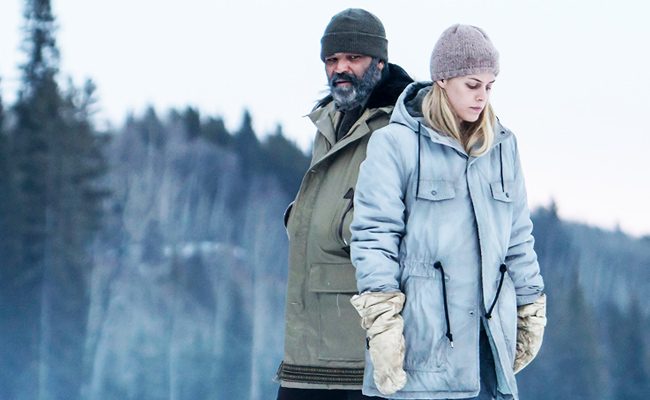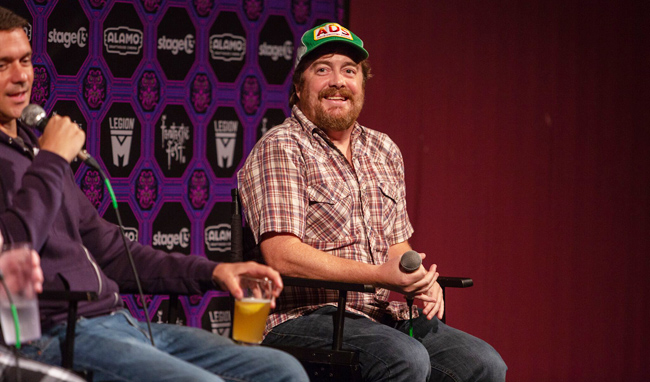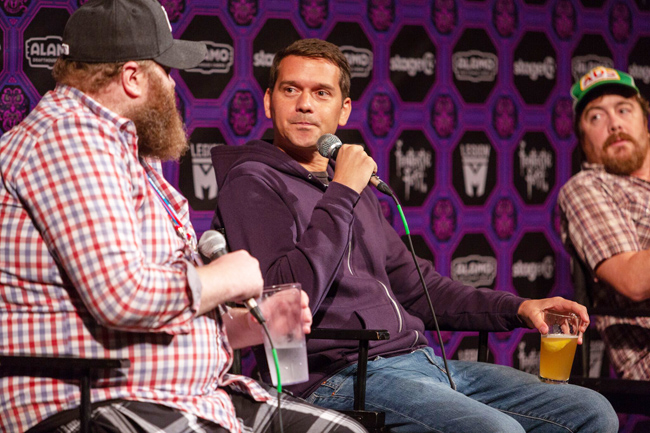
I first met director Macon Blair and actor/writer Jeremy Saulnier about five years ago. It was on a shotgun shooting excursion as part of Fantastic Fest in Austin. They told me they were FilmDrunk readers, and that they had a movie playing at the festival. The movie was Blue Ruin, but I’m not sure that even registered at the time. We exchanged pleasantries and small talk and I kind of forgot about it, as one does with most movies people mention at film festivals, which tend to blur together pretty quickly. And then I actually saw Blue Ruin. Oops. I probably should’ve paid more attention to those guys.
They returned in 2015 with Green Room, with Saulnier again writing and directing and Blair playing a neo-Nazi functionary, a movie which, if anything, doubled down on the action, tension, and gore of Blue Ruin. Though his movies aren’t splatter flicks, Saulnier seems to find ways to incorporate gore into all of them, which he shoots matter of factly but with obvious relish, such that it manages to be both compelling and horrifying.
This year they’re back with Netflix’s Hold The Dark, which Blair adapted from the William Gilardi novel and Saulnier directed. It’s a noticeable step up in terms of both budget and sophistication, not to mention not having to originate all their own material. It’s also a bit of a departure. Hold The Dark, with an incredible cast that includes Jeffrey Wright, Riley Keough, and Alexander Skarsgard, retains all the unapologetic brutality of Blue Ruin and Green Room, but it’s also probably the first Saulnier movie that could be described as “moody.” The resolution isn’t as clear or cathartic this time around, which feels true to the genre, if you think of Hold The Dark as essentially a southern gothic set in Alaska (which I do).
It’s dark and violent, but also a little inscrutable. It’s not going to be for those who require an explanation. Though it’s still perfect for those who love ownage.
HOLD THE DARK: HOLY SHIT THE OWNAGE THE FUCKING OWWWWWWNAGE
— ZODIAC MOTHERFUCKER (@ZODIAC_MF) September 28, 2018
Hold The Dark premiered on Netflix, where Blair set up his own directorial debut, I Don’t Feel At Home In This World Anymore. Which is fun as a critic, because for once it feels like we can discuss a Saulnier/Blair right after the premiere, rather than having to wait for a platform release to slooowly make its way across the country and into the public consciousness. It’s a bit depressing writing things that you know half the audience isn’t going to read for four months.
So Netflix, in most ways, is great for me. But I do wonder if it’s helping to make Blair and Saulnier household names (which they probably deserve to be at this point) or if it’s just building a different kind of niche, parallel to the Festival niche they’ve previously inhabited.
I spoke to them last week at Fantastic Fest.
Macon Blair: [asking about The FP 2: Beats Of Rage] How was that? I saw J-Tro walking around.
Yeah, there were some people that got married because of The FP or something.
Macon Blair: Like they met over mutual fandom?
I think so, and they were there watching. They were at the screening.
Macon Blair: Oh wow. That’s exciting.
So when did this project start for you guys?
Jeremy Saulnier: Well… it came to [Macon] first.
Macon Blair: Yeah, like around 2014. Something like that. I read the book, and then Jeremy read the book, and I was trying to find something to write for him to direct, and this one… I mean, the book was compelling on its own, and at the same time it seemed like… In my mind, I was like, “Jeremy could fucking knock this out of the park.”
Macon Blair: So we pitched ourselves as the people to make this movie, not really sure what to expect, and then we got hired to do it.
Jeremy Saulnier: Yeah, it was actually… We were just coming off of Green Room. We had wrapped Green Room, and we were at the Independent Spirit Awards for Blue Ruin. And we talked about it in Los Angeles, and we had never endeavored to do things within the industry like that. We didn’t know how the fuck development worked or the business side of things. I remember… Macon was very passionate about it. I read the novel, and it was certainly up my alley.
Jeremy Saulnier: I thought atmospherically this is insane. I want to do this. This is…
Macon Blair: Yeah.
What did you like about the novel?
Jeremy Saulnier: Well, I have always self-generated material. We’ve built movies from the ground up before, but this was sort of a shocking experience for me. I had no idea what to expect reading the novel, and my experience as a reader was I wanted to recreate that for the audience of this movie. You know, it’s certainly disturbing. It’s a little bit odd and beautiful. But I just had no idea where it was going, and when these events unfold, I was generally thrilled by it and excited that I didn’t have to go through nine drafts of my own bullshit story and Macon could just set it up for me.
I remember calling my agent and going like, “So how does this work? Macon wants to write it. I really want to direct it. How do we attach ourselves to this material and get this thing done?” And she put me on hold for I think 45 seconds, and she came back, and she was like, “All right. So Macon’s attached to write. You’re attached to direct.” And I was like, “Really? Wow.” So that was the first indication that we had actually achieved access to the industry. It was really fun.

So did that mean you had to buy the option, or how did that work?
Jeremy Saulnier: No, we had fancy people set it up for us.
Macon Blair: Yeah, the author is represented by the same company, so that’s how they had the book in the first place. We were so excited, we actually just started writing the script before the deal went through. We didn’t really know if we would get the job or not, but it was just like … I didn’t want to wait, and so I was working on the script the whole time it was getting figured out. And so then when the contracts were finally done, they were like, “Okay, now you can begin work.” It was just fun replying to that email with the first draft. Like, there you go.
So to me, it felt like… I haven’t read the book, but the movie felt like a southern gothic.
Jeremy Saulnier: Mm-hmm.
What do you think the genre this fits into would be?
Jeremy Saulnier: Oh, sure. I mean, we definitely thought it was a proper Western in some respects.
Macon Blair: Mm-hmm.
Jeremy Saulnier: It has crime thriller elements. Certainly horror iconography, for sure… Chamber drama. I mean, there’s a lot of intimate exchanges in cabins that go on and on for minutes. Minutes. Which is new and exciting for me, because you get to sit back as a filmmaker and let the actors do something, and we created these real environments that they could dig into their characters and just kind of do what they do.
Macon Blair: We used, I think, No Country for Old Men was a reference that you could sort of tell people who were making the decisions and it would… Because that’s very well respected, but also kind of odd, and you’re shifting points of view, and it’s got a confounding ending and all those sorts of things. You can kind of be like, “No, it will work in a way… or hopefully it will work in a way that that did.”
Jeremy Saulnier: Yeah, a sort of bisected narrative. Somewhat vexing in some places, but for all the right reasons.
Mm-hmm. I mean, to me, it seemed like the idea was that there was something a little bit inscrutable and unexplainable at the center of it. How do you keep people from wanting you to solve the mystery at the end?
Jeremy Saulnier: Yeah, we definitely finessed that in the edit, and there was a little bit more on the page, and of course in a novel, there’s a whole lot more depth to it. But it’s a literary work, so when you translate that, as we found, if you over explain this wonderful undercurrent of dread and mystery, it loses its power.
Mm-hmm.
Jeremy Saulnier: There are a few more expository scenes. A few more exchanges. There’s a light touch and we found that you can take out two lines of dialogue and affect everything in the movie, so finding the balance was really tricky. But I think we settled on less is more, and if people feel the pull from underneath .. that sort of undertow… then they can bring whatever they can to the film, and if we spell it out, it loses that magic.
How soon did Netflix get involved?
Jeremy Saulnier: It’s a very difficult movie in that I’ve seen nothing like it, which is why I pounced on it. I did receive a fair amount of submissions, and it’s hard to sort through them, because you’ve either seen them all before, or they’re not quite working in some way, but this was just a unique piece of material. But it’s hard to say, “This will fit right in a certain model, like a huge, theatrical… commit to 20 million in P&A…” Whatever it might be.
Jeremy Saulnier: This project did have a history where we set it up somewhere else, and we had great partners throughout the development process, but we soon came to the realization that this should go to Netflix, because they don’t have the same restraints as other studios, mainly with size and scale of the film, with our amazing ensemble cast. They could take bigger risks. They don’t rely upon the foreign sales model, which is a terribly frustrating thing to run up against when you’re making a movie. They give you just true support, and throughout the process, it was about, “Well, what do you want? What’s best for the story?” Which is sort of shocking for an independent filmmaker to hear.
I mean, they seem great on the front end. On the back end, when you make a Netflix movie, how do you know when a Netflix movie is a success?
Jeremy Saulnier: Oh, I haven’t made one before. So honestly, it can be as simple as bringing it to Fantastic Fests and feeling love. For me, I love the audience here, because it’s beyond just film fans. There’s a really deep understanding of cinema here, and just hearing Twitter responses, the way people get this movie… It’s more than I could ever imagine. It’s exactly what we were targeting.
Macon Blair: Yeah, and Netflix is really upfront with… sort of the numbers with how many clicks it got or whatever. They don’t share that, and I can see how somebody may want that information, but it’s kind of like, not even having the choice to sort of judge the movie against something like that is a huge relief. It’s kind of like, I don’t know. Maybe five people watched it. You don’t have to wonder “Is 5,000 a good number? Should I have gotten 7,000?” I’m making a number up out of thin air, but do you know what I mean?
Yeah.
Macon Blair: It’s like, you don’t have to think about it in those terms.
It also seems like the stats get so detailed that you kind of don’t want to know after a while.
Macon Blair: Yeah.
Like, compared to theatrical, you’re not going to have numbers like … “How long did the average person watch this movie for?”
Macon Blair: Exactly. And it won’t …
Jeremy Saulnier: But I have heard about — you know, Macon’s made a Netflix film, and I’ve heard — I can’t disclose some of the numbers, but they’re actually staggering. [Compared to] the outreach of my first few films, Macon’s viewership dwarfed all my movies combined, basically, in the theaters. It is impressive. And the other thing is, as a filmmaker, we just focus on who’s going to support us telling the stories we want to tell, and how do we keep working?
Sure.
Jeremy Saulnier: It’s fantastic. Netflix is constantly evolving and improving their game, and their outreach is insane, so, you know, I couldn’t be happier.

Filmmaking-wise, did this feel like it was a level of sophistication higher than other movies?
Jeremy Saulnier: Oh, sure. Just in the scope and the scale of it all, absolutely. I said this before, but it’s true. I checked so many boxes as far as first time doing a war sequence, first time working with animals… We did a full, real scout and had amazing real photography take place, and we captured so many things in camera. That was my main thing. The script called for a huge expansion of the scale of filmmaking that we’re used to, but I was dreading having to make that artificial, and if we couldn’t get it in camera, we need it for the story, so I’d be forced somehow… Because we didn’t have a ton of shooting days, and we didn’t have a huge budget for this.
Definitely, we were punching above our weight class for this movie, and we were able to keep it all in camera. We have lots of visual effects, but it’s like stitching and a little bit of CG snow here and there, but it’s all just for continuity. We got the three snowiest weeks of the year, and I let the wolves take the lead when we shot the wolves.
Was it actually in Alaska that you shot?
Jeremy Saulnier: No, we shot in Calgary. Well, Alberta. Just outside of Calgary, and it was like the Revenant crew, so snow for them is just every day. The people come there to do winter movies. One of our grips was wearing shorts the whole time in negative 30 Celsius temperatures. So they have that shit together. But for us, it was like, when we want the wolves to converge, they cannot be CG. We just have to see what they do and build the sequence around them.
Well, I liked that buffalo shot a lot.
Jeremy Saulnier: Yeah, that was something I had to fight for.
I was going to say, was there a buffalo wrangler on set?
Jeremy Saulnier: Oh, yeah. That’s a famous bison. You’ll see that in a few different films, but that was a huge thing for me. Just that… archiving that real fucking beast dwarfing a car on a road, it symbolized so much about the movie, but you know, we went through, should it have been a moose or this and that, but I had to fight for getting a huge beast shipped and set up in this. The lighting is perfect. That’s one of my favorite shots in the whole film.
Mm-hmm.
Jeremy Saulnier: I think it says a ton about the underlying narrative.
And then, getting Jeffrey Wright. Was he high on your list when you were trying to cast it?
Jeremy Saulnier: Absolutely. When this shifted to a Netflix original, that was the first question they asked. “Who do you want?” They didn’t give me the pre-approved list of foreign sales friendly actors or anything like that. And Jeffery is huge, but I just didn’t even have to consider how the calculus of how it would come together. I just said, “Jeffery Wright,” and they said, “Okay.” That was amazing. And then we found Julian Black Antelope, he’s local to the Alberta area–
Macon Blair: That’s Cheeon.
Jeremy Saulnier: He’s amazing. Does his own stunts, too. But other than that, once we hit with Netflix, it was like the casting was extremely simple, because it was like, “Who do you want creatively?” And there’s no denying this ensemble is really exciting.
Macon Blair: Yeah.
His character’s interesting. What are you trying to say with that character in particular?
Jeremy Saulnier: Core?
No, Cheeon.
Jeremy Saulnier: Oh, Cheeon? Well, man, he speaks for himself. I mean, he has this sort of deep connection to Alexander Skarsgard’s character, Vernon Slone. Cheeon and Slone in the book, they have this wordless relationship.
Macon Blair: So much of the novel is all very interior, and it’s just people thinking, and so it made sense cinematically on the page, but we were trying to figure out how to externalize some of these questions that they’re having or dialogues they’re having with themselves or memories or something, and trying to make it something that we can film. …I feel like I went off on a tangent there.
Jeremy Saulnier: Just the Cheeon character.
Macon Blair: Oh, Cheeon. You know, he’s got that line, “Right’s got nothing to do with it,” so he sort of embodies this very nihilistic view of the world and view of people. And with the access to that kind of weaponry, how devastating that can be, just has that level of anger in them, that has that level of devastation that they can unleash.
Jeremy Saulnier: Yeah, he expresses the isolation of the village, and not only for Native Americans, but for all of the inhabitants of the village being marginalized and disregarded. But it’s not just that. Because he’s also deeply connected to this Nordic outsider within in the village.
‘Hold the Dark’ is currently available for streaming via Netflix. Vince Mancini is on Twitter.






